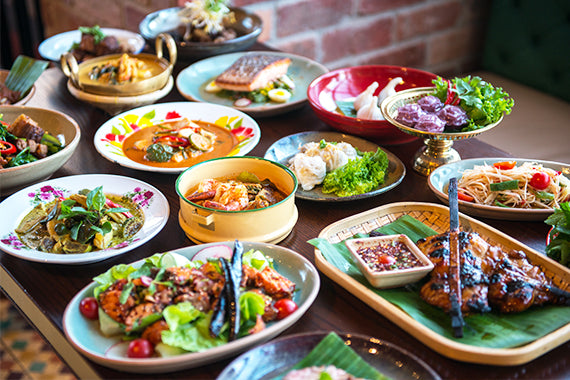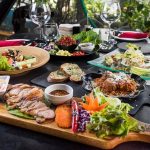:max_bytes(150000):strip_icc()/128892070-56a9495d3df78cf772a570ec.jpg)
Bangkok isn’t just a city—it’s a living, breathing food haven where every corner holds a new taste, scent, and cultural experience. As Thailand’s vibrant capital, Bangkok serves as a gateway to Thai food culture, reflecting the country’s diverse heritage through every dish and flavor profile.
In this guide, we’ll walk you through what makes Bangkok’s food culture extraordinary—from the philosophy behind each bite to the iconic dishes and unspoken dining customs every visitor should know.
Why Food is Central to Thai Culture
Thai people don’t just eat to survive—they eat to celebrate life, family, and connection. Food plays a starring role in every Thai festival, family gathering, and day-to-day routine.
Unlike in many Western countries, asking “Have you eaten yet?” (Kin khao reu yang?) is a common greeting. It shows how deeply food is tied to wellbeing in Thai culture.
“In Thailand, food is not just nourishment—it’s language, love, and legacy.”
Core Elements of Thai Cuisine
Thai food is built around balance, freshness, and complexity. A single dish often contains sweet, sour, salty, spicy, and bitter notes, all working together in harmony.
Essential flavor profiles:
-
Sweet – From palm sugar or fresh fruits
-
Sour – Often added using lime, tamarind, or vinegar
-
Salty – Typically from fish sauce or soy sauce
-
Spicy – Courtesy of fresh chilies or chili pastes
-
Umami – Deep richness often derived from fermented fish or shrimp paste
Each meal aims to stimulate all five tastes without any one overpowering the others. This is what makes Thai food so deeply satisfying and unforgettable.

Eating Customs: How Locals Dine
If you want to eat like a local in Bangkok, understanding the eating etiquette is key.
-
Spoon and fork are the norm, not chopsticks (except for noodles).
-
Dishes are typically shared family-style, with rice as the base.
-
It’s considered rude to put a fork in your mouth—use it to push food onto your spoon.
-
Meals are slow, social affairs, meant to be savored, not rushed.
Whether you’re at a street cart or a luxury restaurant, the rules remain the same: respect the food, the cook, and your fellow diners.
Street Food: The Beating Heart of Bangkok’s Cuisine

Bangkok is often called the street food capital of the world—and for good reason. From sunrise to midnight, vendors line sidewalks, alleys, and markets offering dishes that are cheap, fast, and packed with flavor.
Popular street food you must try:
-
Pad Thai – Stir-fried noodles with shrimp, tofu, and peanuts
-
Som Tam – Spicy green papaya salad
-
Moo Ping – Grilled pork skewers served with sticky rice
-
Khao Man Gai – Thai-style chicken rice
-
Roti Gluay – Banana pancakes with condensed milk
Street food is more than a convenience—it’s a reflection of Bangkok’s history and ingenuity. Many recipes have been passed down for generations and are still cooked over charcoal today.
Read more: Top Street Food Markets in Bangkok
How Spice Shapes Thai Cuisine

Spice is a hallmark of Thai cooking, but not all dishes are fiery hot. In fact, spice is used thoughtfully to balance the other elements of a dish.
Levels of heat:
-
Mild: Great for first-timers (Khao Pad, Pad See Ew)
-
Medium: A gentle tingle (Tom Yum, Red Curry)
-
Hot: Not for the faint of heart (Green Curry, Som Tam Thai)
-
Thai Hot: Beware, this is serious heat, often requested by locals
Don’t be afraid to ask vendors to adjust the spice level to your preference. Saying “Mai phet” (not spicy) or “Phet nit noi” (a little spicy) goes a long way.
The Role of Religion in Thai Food Culture
Thailand is predominantly Buddhist, and this has a clear influence on its cuisine. Many Thais observe vegetarian festivals, and temples often serve meatless, balanced meals.
Even outside of religious contexts, meals are served with a sense of mindfulness, reflecting gratitude for nature and the food itself. It’s common to make a small offering before eating.
Fusion & Foreign Influence in Bangkok Cuisine
While deeply rooted in tradition, Bangkok’s food scene also embraces global influence. Over centuries, Thai cuisine has incorporated flavors from:
-
Chinese – Wok techniques, soy sauce, noodles
-
Indian – Curries and spices
-
Malay – Coconut milk, satay
-
Western – Desserts, breads, and café culture
This blend of tradition and innovation is why Bangkok is a top culinary destination, drawing chefs and foodies from around the world.
Explore Bangkok’s fusion restaurants
Dining Experiences Unique to Bangkok
1. Floating Markets
Enjoy dishes cooked and served from wooden boats—a picturesque, delicious adventure. Try boat noodles, grilled seafood, and coconut pancakes.
2. Night Markets
From Chatuchak to Talad Rot Fai, Bangkok’s night markets combine shopping and snacking in a buzzing atmosphere.
3. High-End Thai Restaurants
Michelin-starred restaurants like Nahm and Sorn elevate Thai cuisine with artistic presentations and regional ingredients.
Bangkok Food by Region
Thai cuisine varies by region, and you’ll find each style represented in Bangkok.
-
Central Thai – Balanced and refined, includes royal recipes
-
Northern Thai – Earthy, mild, with fermented vegetables (Khao Soi, Nam Prik Ong)
-
Northeastern (Isaan) – Bold, spicy, sour dishes (Laab, Som Tam, Sticky Rice)
-
Southern Thai – Fiery and coconut-rich, with heavy Malay influence (Massaman, Yellow Curry)
“Bangkok is a bowl of everything Thailand offers—each bite takes you somewhere new.”
FAQs About Bangkok Food Culture
Is street food safe in Bangkok?
Yes, if you follow the crowds. Busy stalls turn over food quickly, which ensures freshness.
Do locals eat street food daily?
Absolutely. For many Bangkok residents, street food is a way of life—affordable, quick, and consistently tasty.
How much does food cost?
Street meals range from 30–100 THB. Upscale restaurants can cost 500–3000 THB per person.
Is tipping expected in Bangkok?
Tipping isn’t required but is appreciated. Round up your bill or leave 10% at restaurants.
Are there vegetarian or vegan options?
Yes! Bangkok has many vegetarian-friendly stalls and specialty restaurants. Dishes like stir-fried tofu and vegetarian curries are widely available.
Final Thoughts: Bangkok, One Bite at a Time
Bangkok’s food culture is a rich mosaic of flavor, history, and hospitality. From fiery street-side snacks to refined royal cuisine, every dish is a reflection of Thai identity, resilience, and joy.
Whether you’re visiting for a weekend or staying long-term, exploring Bangkok through its food is the most rewarding way to understand the city’s soul.
For more authentic food guides, local travel insights, and real reviews written by passionate Thai food explorers, visit
Angel-Telecom.com – your companion to the best of Bangkok and beyond.


